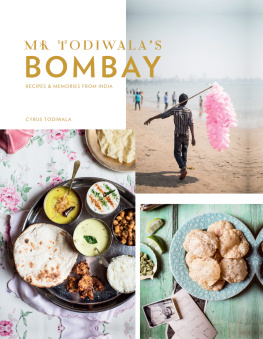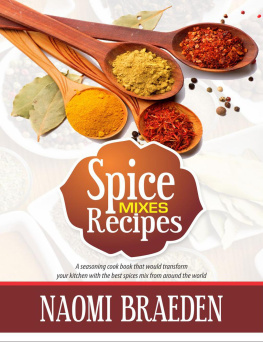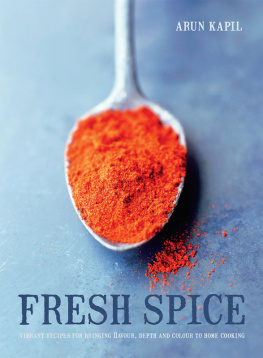CONTENTS
HOW TO USE THIS EBOOK
Select one of the chapters from the and you will be taken to a list of all the recipes covered in that chapter.
Alternatively, jump to the to browse recipes by ingredient.
Look out for linked text (which is blue and underlined) throughout the ebook that you can select to help you navigate between related recipes.
Introduction
Professional chefs often make the mistake of assuming knowledge in their audience, and I must admit that Ive been guilty of that myself. Ive demonstrated recipes to audiences and students as though they will know exactly what Im talking about, and forgotten that I have accumulated my knowledge and experience over many years. This book, a distillation of my collaborations with both great chefs and domestic cooks, aims to put that right. It offers simplified recipes and techniques for making many classic recipes, but it goes one step further than that and bases them around a selection of ten well-known spices hence the Spice Box title of this book.
The criteria for including each spice in this book were versatility the ways it could be used to cook a wide range of dishes and accessibility the ease of buying it. You dont need a vast array of seldom-used ingredients cluttering up your cupboard; just ten inexpensive and readily available spices will allow you to cook fantastic food whenever you like. A recipe for garam masala made from ingredients in the Spice Box can be found. And I am assuming that you will already have black peppercorns and white pepper in your larder.
You will notice that some traditional spices, such as fenugreek and nutmeg, are missing, but go ahead and add these or any other extras as you wish. My recipes are intended to get you started: they are not formulae set in stone. I want you to be inventive and bold, creating your own dish that shows off your personality.
The vital ten spices in my Spice Box are:
1. BLACK MUSTARD SEEDS |
2. RED CHILLI |
3. CUMIN |
4. CORIANDER |
5. TURMERIC |
6. CARDAMOM |
7. CLOVES |
8. SAFFRON |
9. CINNAMON |
10. MACE |
Some of my recipes include additional ingredients, such as curry leaves, that may occasionally be a bit difficult to track down. Dont let that worry you simply try the dish without them, and when you do manage to find them, try the recipe again and notice the difference. Both versions will taste good, but the latter will be even better.
Herbs and other key fresh ingredients include:
FRESH CORIANDER
CURRY LEAVES (PREFERABLY FRESH)
GARLIC
FRESH ROOT GINGER
LIMES OR LEMONS
MINT LEAVES
ONIONS (ALL TYPES, INCLUDING SHALLOTS)
FRESH RED & GREEN CHILLIES
Most of the above are widely available these days and will be a great help when making your first foray into creating delicious Indian food.
Some of my recipes might look long at first glance, especially if they have separate marinades or sauces, but please dont be put off. They are really not complicated or daunting. My advice is to set out everything you require before you start and that will make the process much easier.
In many cases, the core ingredients meat, poultry, fish, seafood or vegetables can be substituted as you wish. Indeed, I want you to feel free to mix and match and try different ingredients. Apart from baking recipes, which do need to be precisely followed, most great dishes have been created through experimentation. At the very worst you might produce something rather different from the original recipe, but if it tastes good, whats the problem? Where I know for a fact that something, such as a marinade, works only with a particular ingredient, I have pointed it out so that you wont waste time and money.
Most recipes are a translation of the authors imagination, knowledge, experience and taste preferences, so they are highly personal. I hope you will enjoy my ideas, but most of all I want you to make them your own. Thats the secret of great food.
Have fun!



SOUPS & STARTERS
BEETROOT ANI NAARL RASAM
Beetroot & coconut rasam
RASAM (PRONOUNCED RUSSUM), AS THIS DISH IS COMMONLY KNOWN IN SOUTH INDIA, IS A VERY VERSATILE AND HEALTHY SOUP. IT IS GENERALLY SIPPED WITH THE MEAL TO ADD FLAVOUR, AND ACTS RATHER LIKE A DIGESTIVE. ALTHOUGH USUALLY MADE WITH LENTILS, THERE ARE MANY VARIATIONS WITHOUT, AND THE FLAVOURINGS ARE SIMILARLY VARIOUS. THE RECIPE BELOW IS A FAIRLY STANDARD VERSION, WITH MY OWN PARTICULAR TOUCHES.
SERVES 6
YELLOW OR PINK LENTILS (TOOR OR MASOOR DAAL) 150g (5oz)
BEETROOT 400g (14oz), topped, tailed and thinly sliced
ONION 1 small, finely chopped
WATER 11.5 litres (12 pints)
GROUND TURMERIC teaspoon
SUNFLOWER OR EXTRA VIRGIN RAPESEED OIL 1 tablespoon
BLACK MUSTARD SEEDS teaspoon
CURRY LEAVES 1012, preferably fresh, shredded; if using dried, soak in water for 1012 minutes, and dry thoroughly before shredding
CORIANDER SEEDS 1 tablespoon, finely crushed
DRIED RED CHILLIES 23 large, whole
CUMIN SEEDS teaspoon
BLACK PEPPERCORNS 56
GARLIC 1 clove, crushed
TAMARIND PULP 2 tablespoons, or to taste, as some tamarind preparations are very strong
COCONUT MILK 1 400ml (14fl oz) can, well shaken
SALT
Wash the lentils well until the liquid clears. Transfer to a bowl, add enough water to cover by 2.5cm (1in) and leave to soak for a few hours.

















